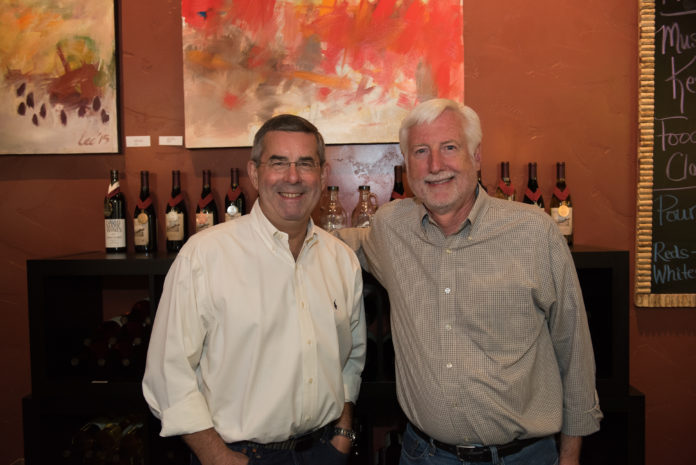
As their fiscal year winds down, the Southwest Washington Winery Association (SWWA) is reflecting on the progress made in their first year and gearing up for 2017.
Established in January, the SWWA consists of 11 area wineries and tasting rooms, all located in Clark County. Charter members are Burnt Bridge Cellars, Cellar 55 Tasting Room, Confluence Winery, English Estate Winery, Emanar Cellars, Heisen House Vineyards, Koi Pond Cellars, Moulton Falls Winery, Olequa Cellars, Rezabek Vineyards and Stavalaura Vineyards.
Michele Bloomquist, secretary for SWWA and owner of Heisen House, shared that much of the association’s focus for 2016 was marketing. At the table they developed their brand; partnered with a local designer who helped them establish the look and feel of their new logo; created business cards; and ran advertising campaigns for the association as well as their annual tours.
The Valentine’s Wine and Chocolate Weekend, Spring Wine Release, Labor Day Weekend Food and Wine Pairing and Thanksgiving Weekend Barrel Tasting all featured event-specific brochures, posters and local print advertising. SWWA also relaunched their website with a new look and feel and established a social media presence on Facebook, Twitter and Instagram.
“We are gaining followers and engagement and intend to increase social media in 2017,” Bloomquist said.
The coming year will see a larger focus on increasing membership within the established four tiers. Rezabek explained that Tier One is defined as all licensed and bonded wineries in Clark County. SWWA may expand to include neighboring counties at some point but not in the immediate future. Tier One members are eligible to hold board member positions, sit on committees, retain voting rights and their winery appears on all printed material.
Tier Two encompasses all other alcohol producers such as breweries, meaderies and distilleries as well as wine bars, bottle rooms and grape growers. These members are not eligible for board member positions but can serve on committees, gain advisory voting rights, are listed on the SWWA website and their logo appears on all printed material.
Wine-affiliated businesses such as restaurants, hotels, touring companies, bottling facilities, equipment vendors and musicians can join Tier Three. These members can serve on committees which include membership, marketing, education, ecology (wastewater) and budgeting.
All other individuals with an interest in wine and the wine industry can come alongside the SWWA as Tier Four members. This could include hobby winemakers, sommeliers, wine stewards, educators and even grape growers who don’t feel they’re large enough or are not looking for the level of responsibility or commitment as Tier Two. This level can also be a part of committees and attend association meetings.
The benefits of a group of wineries joining together to form an association are numerous, but the late Duane Wollmuth, then executive director of the Walla Walla Valley Wine Alliance, summed it up best before his passing earlier this year.
In talking about their signature, annual wine event, Celebrate Walla Walla Valley Wine, Wollmouth shared that the final cost is approximately $236,000, takes place over three-days, involves 60 Walla Walla Valley wineries, and attracts over 600 wine enthusiasts from throughout the country as well as guest winemakers and media.
“But, no one winery can put on such an event, nor would they attract similar attention, by themselves,” Wollmouth said. “As the old saying goes – a rising tide raises all boats. The more attention a wine region receives (or the higher the tide), the more each winery will benefit.”
A more long-ranging goal of SWWA is to seek American Viticultural Area (AVA) status. One of the minimum requirements for this prestigious designation is one square mile of vineyards. That’s 640 acres planted to vines. In a county with, possibly 200, the SWWA has work to do and, since not all area wineries grow grapes, this is a vision that causes pause for some of the members.
Make no mistake; AVA status benefits all winemakers in a wine region. In fact, statistics support that AVA status increases tourism dollars for a myriad of businesses for the sole reason that wine enthusiasts prefer traveling to places they can explain to friends and family. Additionally, without an AVA status, local wineries that grow their own grapes are not able to print ‘estate grown’ on their label. That is a privilege reserved for AVA designation only. Places like English Estate Winery – who grow anywhere from 95 to 100 percent of what they bottle – and Three Brothers Winery – which celebrated 2016 as their fourth year in a row bottling 100 percent estate grapes – cannot print ‘estate grown’ on their wine labels.
That is not to detract from the message sent in forming an association.
Averyl Dunn, communications manager for the Washington State Wine Commission, said “I love working with associations to keep up with the vibes, the energy and the happenings of that area. Individual winery communication is, of course, still a part of our jobs and what we love to do, but an association really maximizes our connection between every winery.”
In our collaborative economy, members of the SWWA can enjoy a collective voice and be stronger together than they are standing alone.
According to Bloomquist, 2017 will focus on targeting area businesses that could benefit from cross-pollinating with the association. In addition to restaurants and hotels, she offered up spas, tour companies, limousine services, tea rooms and antique shops.
“I think Southwest Washington is one of the best kept secrets in the Northwest,” Bloomquist said.



